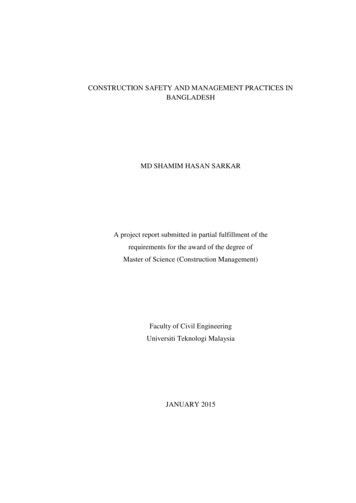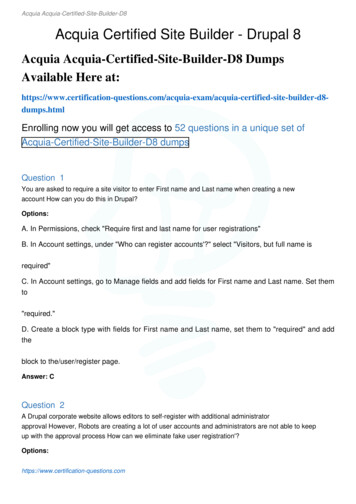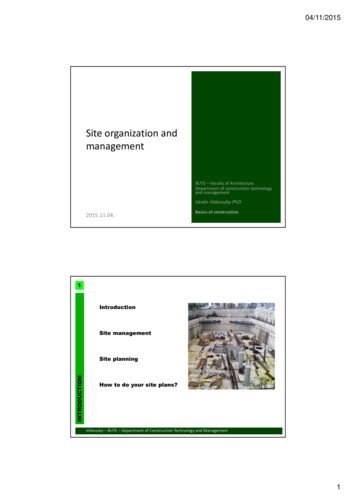
Transcription
12 ‐ Construction SiteManagementMary Halley
Module Content Importance of construction site management toRunoff Reduction Common Construction Mistakes Avoiding GIP failure
Time to Wake Up! The most important factor determiningthe success or failure of infiltration GIPS isConstruction Site Management. Infiltration GIPS will fail if they arecompacted or sediment discharges to them.
Same Site, Different Stages, Very Different RunoffStage of DevelopmentTotal Suspected Sediment (TSS)Concentration (mg/L)Data SourceOpen Land (Urban)70 (median)NURP, 1983During Construction20,000 to 160,000McCaleb et al, 2008Post Construction69 to 100 (median)NURP, 1983
Post‐Construction BMP Mechanisms Infiltration: Runoff reduction & pollutant removal (all pollutants) Evapotranspiration: Runoff reduction & pollutant removal (nutrients) Settling: Pollutant removal (TSS, Phosphorus, Metals) Filtration: Pollutant removal (TSS, P, N, ionInfiltration FiltrationUnderdrain to Surface
Sediment Impacts to BMP Mechanisms Infiltration: Clogs void spaces in porous soils and permeable pavements Evapotranspiration: Prevents infiltration and water uptake throughroots, killing the vegetation Settling: Destroys the settling capability and cause uncontrolled sedimentdischarges if left unmaintained Filtration: Covers forest litter and vegetation, clogs void spaces in poroussoils and in underdrains
From Design Approval to OperationApproved GIP – BioretentionActual GIP – Sediment Basin
Different Stages, Similar GoalsDuring ConstructionPost Construction Minimize the extent and Avoid soil disturbance andduration of disturbance No discharge of sedimentand construction materials Protect streams, wetlandsand other natural features Inspect and maintain BMPs Stabilize disturbed areascompaction in GIP areas No discharge of first 1‐inchof rainfall (no pollutants) Protect streams, wetlandsand other natural features Inspect and maintain BMPs Keep open space stabilizedThe transition from construction to post-construction is themost critical time to ensure Green Infrastructure success!
GIPs are typicallyinstalled in final phasesof construction,primarily to protectthem from sedimentdischargesMontgomery County, MDBioretention
GIPs look different fromtraditional BMPs.Subcontractors may notrealize these arestormwater controls!
Final stage subcontractors,(home subcontractors,landscapers) need to have fullknowledge of site GIPs too!Vehicles, equipment oractivities in the wrong area cancause failure.
The Top 10 List of Poor Construction Site Practices1. Poor on‐site communication between contractor andsubcontractors, vendors, landscapers2. Failing to follow the approved construction sequencingand site phasing practices shown on EPSC plans3. Installing Permanent Stormwater BMPs too early4. Failing to stabilize areas upstream of PermanentStormwater BMPs before installation5. Failing to protect areas where BMPs will be installed6. Failing to protect native vegetation or soil areas7. Failing to clean‐out temporary BMPs before installation ofGIPs8. Mass grading9. Failing to install and maintain the proper EPSC BMPs10. Failing to repair erosion areas quickly after exposure
Communication Modes Signs, fencing and tape!!Morning tailgate meetingsSubcontractor check‐insOn‐site plan updatesOn‐site plan billboardsSite inspection documentsTandem inspections
Communication gnerSubcontractor
Construction Phasing & Sequencing Most GIPs rely on uncompacted soil and/or healthy vegetation, soconsider: Adjustments to other construction activities to accommodate the GIP(parking areas, equipment storage, materials stockpiles, etc.)Performing inspections during landscape installationThe time of year, anticipated weather, and need for watering plantsA short‐term and long‐term plant watering plan
Construction Phasing & Sequencing Before GIP installation: Contributing drainage areas to GIPs must be stabilized Unprotected GIP areas may require soil amendments The potential for GIP compaction must be eliminated Post‐installation protection must be planned and ready
Clean GIP InstallationsSource: www.lid-stormwater.net
Final Thoughts Design plans should include phasing, sequencing,protection, and vegetation planning and maintenance. County Site Plan Reviewers and Site Inspectors will bemore diligent about these elements – so you should too! Corrective actions will be required if there is evidence ofsoil compaction, sediment discharges to GIPs, or unhealthyvegetation.
Module Topic Summary Importance of construction site management toRunoff Reduction Common Construction Mistakes Avoiding GIP failure
Questions?
Post Construction Avoid soil disturbance and compaction in GIP areas No discharge of first 1‐inch of rainfall (no pollutants) Protect streams, wetlands and other natural features Inspect and maintain BMPs Keep open space stabilized The transition from construct











